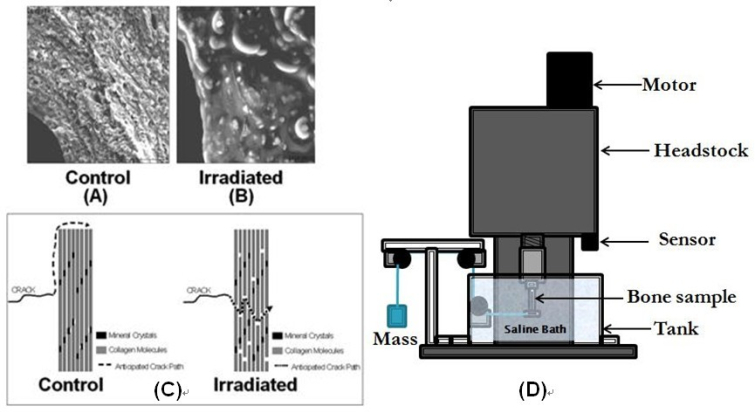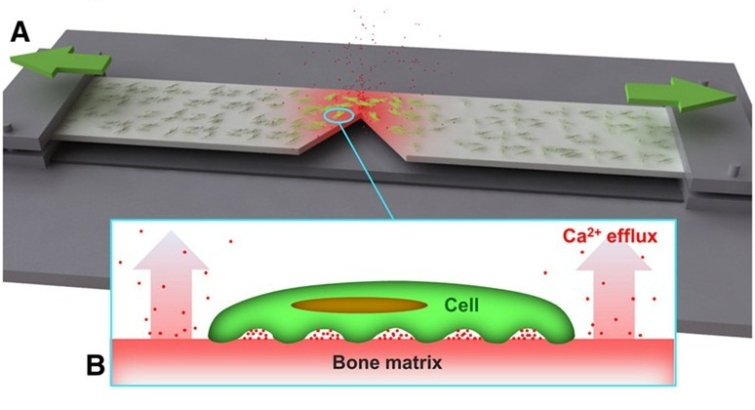The sad face of stress
-
Frequency Aqueous environment Stress amplitude Temperature (FAST)
The FAST (Frequency Aqueous environment Stress amplitude Temperature) Machine is a device built to perform fatigue tests of cortical bone specimens. The device was conceptualized by Dr. Ozan Akkus when applying for a Musculoskeletal Transplant Foundation grant to test the effects of gamma sterilization of cortical bone grafts in clinical applications. Cortical bone allografts are used in surgery to aid in fracture repair. Before an allograft can be implanted in the human body, it must be sterilized via gamma radiation. This sterilization process decreases the strength of the allografts such that they often fail to fix the fracture. The device will be used to determine the fatigue lives of untreated, gamma irradiated, and radioprotected cortical bone specimens. The goal of this research is to develop a radioprotection technique that preserves the strength of cortical bone during the sterilization process so that allografts are more successful in clinical applications.
The FAST Machine is an autonomous reverse bending fatigue device, constructed for less than $2,500. The FAST acronym stands for the four components of the device the user is capable of adjusting: the frequency at which the specimen is fatigued, the aqueous environment in which the specimen is fatigued, the magnitude of stress at which the specimen is tested, and the temperature of the aqueous solution. These characteristics allow cortical bone specimens to be tested in physiologically relevant conditions at accelerated rates. The accelerated rate of testing allows fatigue tests to be performed in hours or days as opposed to days or weeks, making fatigue testing more efficient.
A prototype was initially built by a team of undergraduate Biomedical Engineering students, with assistance from Jay Bensusan (Research Engineer for the Musculoskeletal Mechanics and Materials Lab) and Dr. Clare Rimnac (Associate Dean to the Case School of Engineering), as an assignment for EBME 380: Design for Biomedical Engineers. The project was then continued by one of the EBME 380 students, Emily Moore, in fulfillment of her MS in Biomedical Engineering at CWRU.
-
Effect of Gamma Radiation on the Functional Fatigue Life of Cortical Bone Grafts
Cortical bone grafts are utilized frequently for skeletal reconstruction, spinal fusion and tumor surgery. Due to its efficacy and convenience, terminal sterilization by gamma radiation is often essential to minimize disease transmission and infection. However, the impairment in the material properties of bone secondary to gamma radiation sterilization is a major concern since bone grafts experience mechanical loads during their function. There is not enough information on the functional lifetime of allografts in the body where the graft is subjected to repeated loads below the monotonic failure strength. The dynamic nature of such physiological loads are the best replicated by fatigue tests. Therefore, fatigue of gamma radiation sterilized bone tissue needs to be assessed so as to be able to predict the functional life time of bone grafts subjected to ionizing radiation; furthermore, the evident reduction in fatigue life needs to be mitigated.
Results of an earlier study from our group explaining the material level basis of gamma radiation induced bone embrittlement. (A and B) Scanning electron microscopy images of osteons from fracture surfaces indicate a more flat fracture path for irradiated bone. (C) It is proposed that the scission of collagen molecules of collagen fiber results in disappearance of crack deflection and that the crack travels through the bulk of the fiber. (D) The schematic representation of the FAST machine.
An accelerated fatigue loading device, FAST (Frequency Aqueous environment Stress amplitude Temperature) was fabricated, to conduct fatigue tests of cortical bone specimens under physiologically relevant conditions (Figure 1D). Cortical bone samples are loaded in fatigue using the accelerated fatigue device at various stress levels to construct S-N Curves. The effects of clinically relevant dose of gamma radiation on the fatigue behavior of cortical bone can be assessed by FAST machine.
The next goal is to mitigate the degradation in fatigue life of gamma radiation sterilized bone by using radioprotectant solutions. Gamma radiated and radioprotectant treated bone can be tested in FAST machine to generate S-N curve. These S-N curve patterns can be compared to those obtained for radiated and unirradiated samples to determine whether radioprotectant treated-radiated samples have improved fatigue behavior over irradiated samples, and, if improved, whether the improvement is to the level of unirradiated control samples.
Bone matrix as a “mechanochemical transducer”, converting post-yield strains at a stress raiser (A) to into cell-perceivable chemical signal in the form of Ca2+ efflux (red dots) from the bone matrix to the pericellular niche (B). Direction of tensile loading is marked with green arrows.
Subjected to continuous loading, the skeleton should sustain microfractures and prefailure overload episodes by bone remodeling. The remodeling of damaged region by bone cells targets critically loading region by basic multicellular unit (BMU), composed with osteoblast and osteoclast. However, the mechanism by which the targeting occurs is a matter of ongoing debate. In this study, we hypothesized bone matrix as mechanotransducer: mechanical force induced ruptures and debonding in microdamaged loci result in alternation of chemical environment in the pericellular niche, which is followed by calcium efflux from bone matrix.The proposed studies will test the hypothesis that mechanically induced calcium efflux from microdamaged regions of bone matrix plays pivotal role in bone remodeling by triggering intracellular calcium signaling: stimulating anabolic (differentiation, proliferation and/or ECM synthesis) as well as catabolic (resorption) effects in key osteoblast and osteocyte, and triggering downstream signaling pathways.
-
Biomechanical study of iatrogenic subtrochanteric fractures
In the United States, there are approximately 350,000 hip fractures annually, a diagnosis that is associated with high morbidity and mortality. Internal fixation with screws is a common treatment method for stable and even unstable femoral neck fractures that allows patients to quickly return to ambulation. Unfortunately, patients may sustain subtrochanteric fractures post-operatively with little to no trauma. Though not extremely common, the incidence of these iatrogenic fractures is around 3%. Most of the knowledge about such fractures comes from retrospective analysis of patients. The holes created on the lateral femoral cortex for introduction of screws create stress risers, which may predispose to fractures in the subtrochanteric region of the femur. In this study, we apply forces to synthetic (Sawbones) and cadaveric femurs in a novel manner, which allows creation of subtrochanteric fractures. With a loading model that allows creation of subtrochanteric fractures, the elements of internal fixation that contribute to iatrogenic subtrochanteric fractures can be studied in vitro. This study will add to the current understanding of subtrochanteric fractures and hopefully lead to improvements in either surgical technique or equipment to reduce iatrogenic subtrochanteric fractures.





